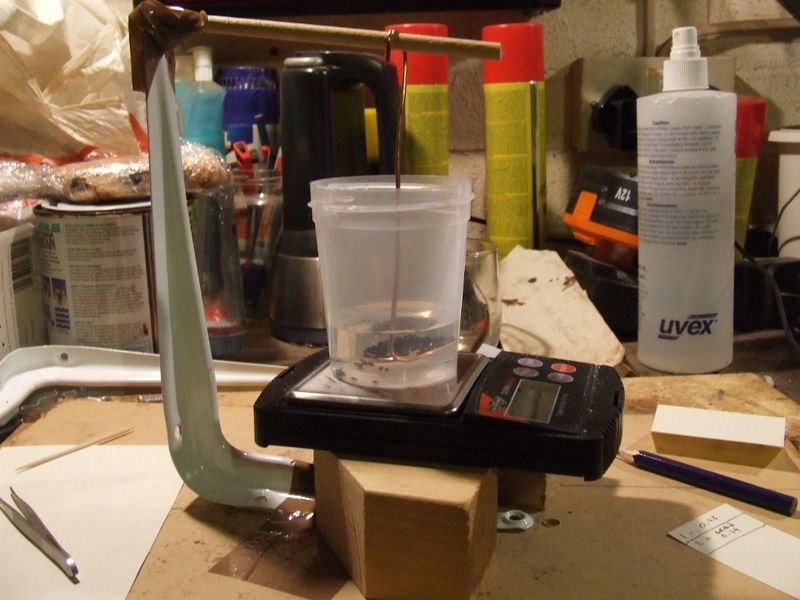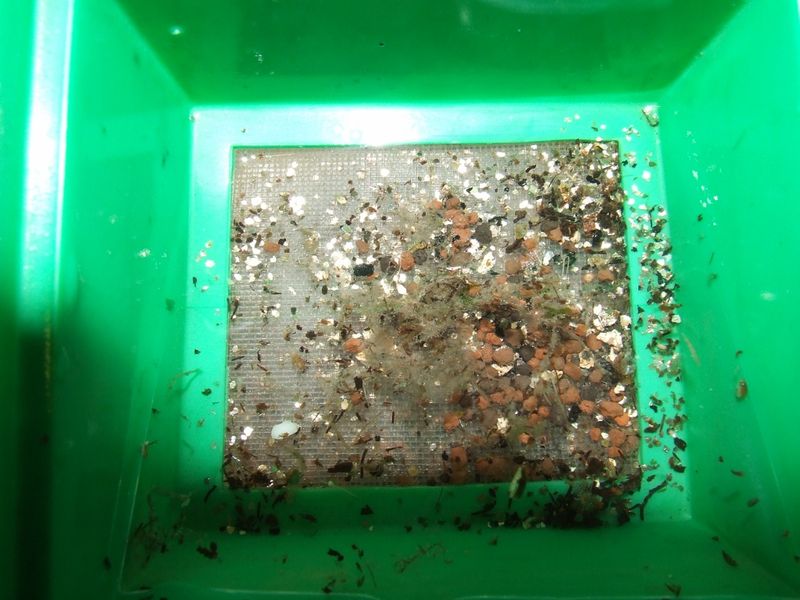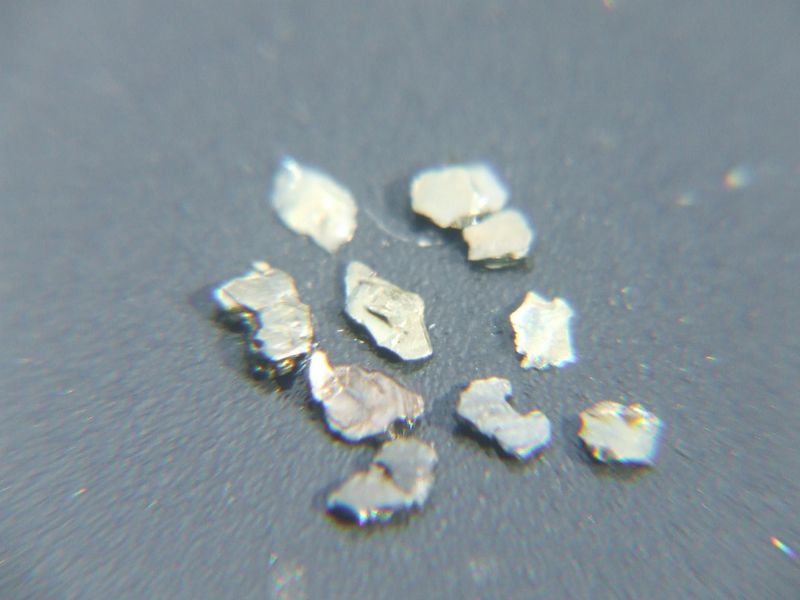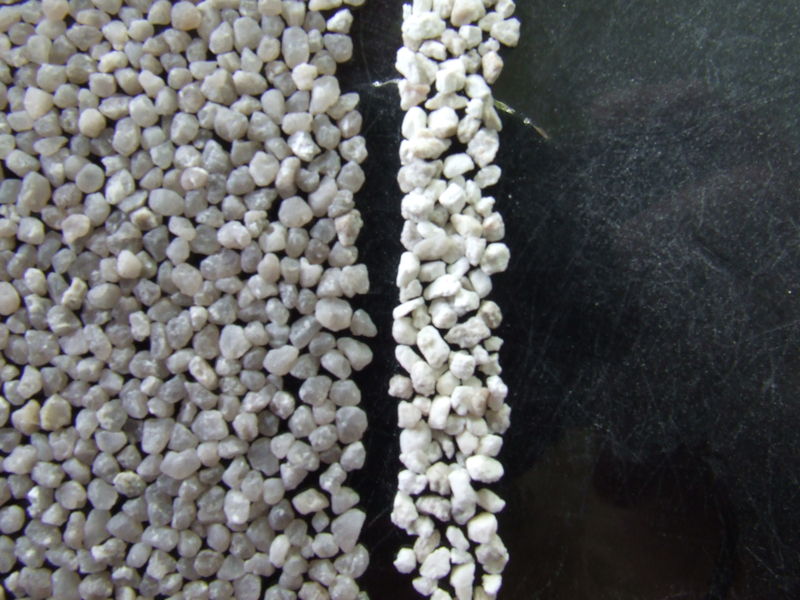| View previous topic :: View next topic |
| Author |
Message |
Pete Richards
Site Admin

Joined: 29 Dec 2008
Posts: 846
Location: Northeast Ohio



|
 Posted: Mar 20, 2015 11:56 Post subject: Re: Mysterious Black Crystals (Something Fishy!) Posted: Mar 20, 2015 11:56 Post subject: Re: Mysterious Black Crystals (Something Fishy!) |
|
|
One thing to consider is that many or even most minerals form at elevated temperatures and often elevated pressures, conditions vastly different from earth surface conditions. Many grow by crystallization of molten rock; few grow from an aqueous solution. Very few of them have even a remote chance of growing in your fish tank. This is certainly true of mica. If it grew in your tank, it is not mica.
It would be useful to consider what chemical materials are present in the tank, presumably as constituents of the water you occasionally add or replace. It's probably a fairly short list. But the materials to make the grains obviously have to come from somewhere.
I like Alfredo's suggestion to incinerate some of the stuff and see how much of it disappears. That part will almost certainly be organic, and therefore not a mineral at all.
_________________
Collecting and studying crystals with interesting habits, twinning, and epitaxy |
|
| Back to top |
|
 |
Andy Love
Joined: 18 Mar 2015
Posts: 13
Location: Milton Keynes


|
 Posted: Mar 20, 2015 12:17 Post subject: Re: Mysterious Black Crystals (Something Fishy!) Posted: Mar 20, 2015 12:17 Post subject: Re: Mysterious Black Crystals (Something Fishy!) |
|
|
With Peter champing at the bit for news of density etc., I'd better employ a second typing finger ...
When a crystals-plus-gravel mix is swirled in or dropped through water, both elements appear to behave similarly.
When a bunch of black crystals is put into water some of the smaller, flatter, crystals 'float' on the surface tension until the latter is broken : then they drop like little stones!
Clearly such woolly observations weren't going to earn me much currency hereabouts! So I resolved to do what I could towards achieving an estimation of the crystals' specific gravity. Even a rough idea would be better than nothing, I figured.
I read through Cascaillou's piece on SG measurement and concluded that I might be able to have a bash at his Method #2 (even though he says it's not the preferable one for small crystals).
I calibrated my electronic scale and used the water I 'make' for my aquariums : it's reverse osmosis water and I checked that its conductivity was zero before using it.
The most difficult part of construction was finding the material for the 'basket' to hold the crystals. In the end I had to eviscerate a length of electrical cable and used the resulting copper core to fashion a basket. Not ideal, I know.
I ran the procedure four times, each with exactly two grams of crystals. A further difficulty arose : as referenced above, a few of the crystals 'floated'! Pushing them down with a pre-soaked wooden cocktail stick didn't guarantee all of them landing on the basket. I think the piccie attached shows that a few of them missed their target! However, there was nothing I could do about that, so I continued.
Applying Cacaillou's formula, the results of each of the four tests were :
#1 : 2.59
#2 : 2.63
#3 : 2.56
#4 : 2.77
The average being 2.66 . I'm unlikely to improve on that accuracy unless I get access to a 'professional' rig.
Hmm ... I wonder how I could follow up Alfredo's suggestion of sending a sample away for PXRD.
| Mineral: | [Unknown] |
| Description: |
Milton Keynes
c2mm
An attempt at discovering the approximate specific gravity of the crystals. |
|
| Viewed: |
60664 Time(s) |

|
|
|
| Back to top |
|
 |
Josele

Joined: 10 Apr 2012
Posts: 410
Location: Tarifa, Spain



|
 Posted: Mar 20, 2015 12:29 Post subject: Re: Mysterious Black Crystals (Something Fishy!) Posted: Mar 20, 2015 12:29 Post subject: Re: Mysterious Black Crystals (Something Fishy!) |
|
|
As said, most minerals can't grow in aquarium conditions, that reduces possibilities to only some sedimentary minerals.
These data will help to better know the growing conditions:
- sand composition
- water temperature
- maximum temperature of sand/gravel
- water pH
- product used to pH control
- water analysis or at least which type of water is used
_________________
Josele |
|
| Back to top |
|
 |
Pete Modreski
Site Admin

Joined: 30 Jul 2007
Posts: 710
Location: Denver, Colorado



|
 Posted: Mar 20, 2015 12:49 Post subject: Re: Mysterious Black Crystals (Something Fishy!) Posted: Mar 20, 2015 12:49 Post subject: Re: Mysterious Black Crystals (Something Fishy!) |
|
|
Interesting, Andy. I understand why you've been curious about this. So, the grains seems hard, and not easy to crush. So, some of the possibilities that come to mind...
They are just quartz from the gravel, which became coated with black... (what?)
They are some other mineral from the gravel (feldspar, perhsaps?) that was preferentially coated by the black stuff.
It was indeed some "mineral" (or better say, chemical compound) that was deposited in the interstices between the gravel particles--but what, I have no guess.
One would often suspect that a black coating (if not organic) could be manganese oxide, but your XRF data do not even list Mn, so that seems not to be a possibility.
And, your rough specific gravity measurements do seem to indicate that the black material is of the density of "ordinary" mineral/gravel grains--quartz or feldspar.
Re-reading all you wrote originally, it's interesting about the pyrite; having that precipitate, though of course "theoretically" to be expected, is a little surprising to see that it actually did deposit in your aquarium. And I see that you had already separated out the magnetite--of which, my guess would be that it's original magnetite that was part of the sand or gravel--it would be "remarkable" if magnetite actually grew in your aquarium (being as it's normally a high-temperature mineral).
Of course, the best way to get a more informed answer, to have have a pinch of the "black sand" analyzed by X-ray diffraction. Now, I wouldn't be surprised if that just ended up showing a mixture of quartz & feldspar--which would probably mean that gravel particles had become coated by "unknown black stuff". But if some "mystery chemical compound" had been deposited to form these black grains, XRD should show what it is--unless, again, it's just a trace of black material, on gravel particles.
|
|
| Back to top |
|
 |
alfredo
Site Admin

Joined: 30 Jan 2008
Posts: 1014



|
 Posted: Mar 20, 2015 15:34 Post subject: Re: Mysterious Black Crystals (Something Fishy!) Posted: Mar 20, 2015 15:34 Post subject: Re: Mysterious Black Crystals (Something Fishy!) |
|
|
| Andy, you can find a good x-ray diffraction service for minerals at attminerals (dot) com, in San Diego, which costs $40 and gets the results to you generally within 48 hours. If you have a local university with a mineralogy department, you might be able to persuade the mineralogy professor to do it for you for free but, as you can imagine, they are usually overworked and consequently very slow to get it done, and then only if the prof happens to have an interest in the material. If curiosity is burning you up, I recommend the commercial service.
|
|
| Back to top |
|
 |
Pete Richards
Site Admin

Joined: 29 Dec 2008
Posts: 846
Location: Northeast Ohio



|
 Posted: Mar 20, 2015 16:17 Post subject: Re: Mysterious Black Crystals (Something Fishy!) Posted: Mar 20, 2015 16:17 Post subject: Re: Mysterious Black Crystals (Something Fishy!) |
|
|
Andy, you mentioned pyrite, but we have not seen a good picture of it. I think I see a few glints that might be it in some of your images.
Can you get a reasonably close-up picture of the pyrite?
In this environment, pyrite should not precipitate if, as you suggest, the interface layer where these pyrite grains were found was aerobic. And if pyrite formed anywhere in the "sediment", it should have been a black mud, and in fact probably FeS and not pyrite, FeS2. There is a lot of evidence of specialized bacteria precipitating iron sulfides as part of their metabolism, but not as shiny yellow-colored grains that a mineralogist or once-potential geologist would recognize by eye as pyrite.
_________________
Collecting and studying crystals with interesting habits, twinning, and epitaxy |
|
| Back to top |
|
 |
Volkmar Stingl
Joined: 23 Sep 2012
Posts: 1004
Location: Innsbruck



|
 Posted: Mar 22, 2015 01:12 Post subject: Re: Mysterious Black Crystals (Something Fishy!) Posted: Mar 22, 2015 01:12 Post subject: Re: Mysterious Black Crystals (Something Fishy!) |
|
|
| In one of the magnified pictures (40x) I see clearly a cleavage as it is typical for micas.
|
|
| Back to top |
|
 |
Andy Love
Joined: 18 Mar 2015
Posts: 13
Location: Milton Keynes


|
 Posted: Mar 25, 2015 09:16 Post subject: Re: Mysterious Black Crystals (Something Fishy!) Posted: Mar 25, 2015 09:16 Post subject: Re: Mysterious Black Crystals (Something Fishy!) |
|
|
Just popping in to assure you all that I haven't abandoned you!
I'm awaiting replies to e-mails that just may shed some further light. Amongst that burst of communications, I made enquiries about XRD services in the UK, though I'm not terribly hopeful that any that do reply will be economically feasible. I'm most grateful to Alfredo for his suggestion and may well finish up adopting it.
In the meantime, I've made another observation and will return with news of that if-and-when I've convinced myself that it's real.
To keep you going, here are some comments re the pyrites ...
I noticed them when I passed some substrate through a kitchen sieve into a bowl of water in order to separate out some of the larger black crystals. The effect was one (if you'll pardon the expression) of a golden shower raining down into the bowl.
Pic#1 is of a brine shrimp sieve that I put in the path of what was coming through the kitchen sieve. Pic#2 shows a group of larger pyrite fragments.
The fragments are formed of thin sheets that broke apart easily (and annoyingly) when tweezered onto the surface I used to photograph them for you.
It may be useful for us to bear in mind that this phenomenon occurred in an environment where some/most/all surfaces are covered with a biofilm. As demonstrated to me in a different exercise, conditions locally within a biofilm may cause unexpected things to happen. That may, or may not, be relevant here but I thought I'd just mention it.
More news as I get it ...
| Mineral: | Pyrite |
| Description: |
Milton Keynes
1-2mm
Some of the pyrites as separated from the substrate. |
|
| Viewed: |
79282 Time(s) |

|
| Mineral: | Pyrite |
| Description: |
Milton Keynes
c2mm
Pyrite crystals isolated from the substrate. |
|
| Viewed: |
79432 Time(s) |

|
|
|
| Back to top |
|
 |
Pete Modreski
Site Admin

Joined: 30 Jul 2007
Posts: 710
Location: Denver, Colorado



|
 Posted: Mar 25, 2015 10:41 Post subject: Re: Mysterious Black Crystals (Something Fishy!) Posted: Mar 25, 2015 10:41 Post subject: Re: Mysterious Black Crystals (Something Fishy!) |
|
|
Dear Andy,
Although your fragments look shiny, I think I can guarantee you that they are indeed MICA, not pyrite. I'm sure the others from the Forum who may reply, will agree with this. You can confirm it by jabbing one with the point of a pin or needle; they will be soft, get indented, and the flake will tend to split apart. Pyrite, on the other hand, is hard and brittle--there would be no mark or indentation, unless you crunched it so hard as to break the pyrite grain (which would probably bend the point of a needle, too).
And this mica, must definitely have been a component of the sand or gravel--NOT something that could have formed in your tank!
Cheers, Pete
|
|
| Back to top |
|
 |
James Catmur
Site Admin

Joined: 14 Sep 2006
Posts: 1482
Location: Cambridge



|
 Posted: Mar 25, 2015 13:33 Post subject: Re: Mysterious Black Crystals (Something Fishy!) Posted: Mar 25, 2015 13:33 Post subject: Re: Mysterious Black Crystals (Something Fishy!) |
|
|
| Looks like mica to me
|
|
| Back to top |
|
 |
Pete Modreski
Site Admin

Joined: 30 Jul 2007
Posts: 710
Location: Denver, Colorado



|
 Posted: Mar 25, 2015 14:51 Post subject: Re: Mysterious Black Crystals (Something Fishy!) Posted: Mar 25, 2015 14:51 Post subject: Re: Mysterious Black Crystals (Something Fishy!) |
|
|
| P.S., Andy, as opposed to being "regular mica", these might also be pieces of vermiculite (a type of mica), such as is used in packing material, potting soil, absorbent for liquids, etc.
|
|
| Back to top |
|
 |
Andy Love
Joined: 18 Mar 2015
Posts: 13
Location: Milton Keynes


|
 Posted: Apr 10, 2015 06:22 Post subject: Re: Mysterious Black Crystals (Something Fishy!) Posted: Apr 10, 2015 06:22 Post subject: Re: Mysterious Black Crystals (Something Fishy!) |
|
|
I'm still here and still busy gathering data for you to evaluate.
I contacted a range of lab services here in the UK that purported to offer XRD. One or two of them in fact don't (despite what Google claimed) ; others were just too expensive for me ; a couple didn't reply in within my patience time-frame!
So I took up Alfredo's suggestion and sent samples to John Attard. Sod's Law dictated that as soon as I had done that, one of the non-respondents would reply. In fact it was barely a couple of hours after I'd returned from the Post Office that a lab in one of the London Colleges offered to do XRD for free - so long as there was no commercial gain to be had ; and so long as I was prepared to wait since they are very busy. I have now sent the samples off to London.
In the meantime, John Attard phoned (yesterday) to say he'd received the samples and to collect my payment details. His results came back less than an hour later!
I'm uncertain as to whether I can copy the results to here without catastrophically contravening the forum posting rules for attachments, so I won't do that without express permission. Briefly, though : the larger black crystals are estimated to be edenite/magnesiohornblende ; and the tiny gold flakes to be 'mainly' phlogopite mica.
Through diligent rummaging for info of a family nature, I came across an old hard disk drive which (it turned out) contained text and images recorded as I was setting up this aquarium. I can confirm with 95% confidence that I didn't, either then or subsequently, add either of these two materials to the tank. I'm reserving the 5% because I see that I added a little plant-growth medium underneath the sand : it doesn't appear to contain either substance (it would be obvious) but I need to be sure, so I'm doing some checks with its producer. I see also that there was some silicone sealant used to stick bits of the aquarium's décor together - but I'm disregarding that for the time being because ...
... Suspicions are clearly now focussing on the proprietary aquarium gravel that I used.
I'm in conversation with its manufacturer and am learning about its production. Apparently the basis for it is mined in Bavaria. The quartz crystals that come out of the ground are (they say) associated with a certain amount of feldspar ; maybe there's other stuff, too. The material is size-graded and the resulting correctly-sized grains are coated with resin, 'natural' colouring and iron oxide. I have asked for a sample of the grains as they are before they receive these coatings and have just had a reply to say they're sending me some. I'll report back when it arrives.
Something that disturbed me just a little as I was gathering samples to send to London was the discovery of a (relatively) humungous black crystal : much larger than the 'average' size of them ; and much larger than any of the grains of gravel. Hmmm.
Anyway, that's my update for now. I haven't forgotten the questions (up-thread) about minerals in the water and about pH regulation and will return to them in due course if-and-when it seems appropriate.
Thanks for your continued attentions.
|
|
| Back to top |
|
 |
Andy Love
Joined: 18 Mar 2015
Posts: 13
Location: Milton Keynes


|
 Posted: Apr 29, 2015 08:25 Post subject: Re: Mysterious Black Crystals (Something Fishy!) Posted: Apr 29, 2015 08:25 Post subject: Re: Mysterious Black Crystals (Something Fishy!) |
|
|
Hi Everyone
I'm still making progress, albeit rather slowly. Since many of the photographs that I need to illustrate my story don't 'fit' here, I'm collating them on the fishkeeping forum which I inhabit and will link you to it when I'm done. There you will eventually find further details of water chemistry etc.
At the moment. though, I have an issue on which I'd appreciate some advice, if you'd be so kind.
The attached photograph depicts the material that is later given coatings to produce the relevant aquarium gravel. Although everything is coloured some shade of grey or white, a fraction of the grains are clearly whiter than the rest ; others I'm not so sure about.
As you can see, I've tweezered-out grains that are very obviously much whiter than the rest : I'm reliably informed that these latter grains are feldspar.
I would like to optimise my feldspar-tweezering-out ability (I'm not going mad - I have a specific reason for doing so!). So is there any tip or trick that you can pass on to me to help me extract as much of the feldspar as possible from a measured sample of gravel?
I have 445 gams of the 'raw' gravel to play with, by the way.
| Mineral: | Quartz and Feldspar |
| Dimensions: | 1-2mm |
| Description: |
| The raw material from which the aquarium substrate is manufactured. |
|
| Viewed: |
74916 Time(s) |

|
|
|
| Back to top |
|
 |
Andy Love
Joined: 18 Mar 2015
Posts: 13
Location: Milton Keynes


|
 Posted: May 10, 2015 06:32 Post subject: Re: Mysterious Black Crystals (Something Fishy!) Posted: May 10, 2015 06:32 Post subject: Re: Mysterious Black Crystals (Something Fishy!) |
|
|
I'll take that as a 'no', then?
I did have a bash at this, using the resources at my disposal. My most successful effort (not that that is saying much!) was the construction of a light box into which I put a uV lamp (368nm). 'Feldspar' crystals laid on top appeared opaque ; quartz crystals laid on top appeared transluscent.
The trouble was that the quartz crystals that I could see under white light having a partial coating of 'feldspar' appeared opaque, too, under uV. (I think I can just about stay within the forum's rules if I post a pic of the result.)
So I had to abandon that as a reliable method of efficient separation. Unless a different method can be suggested, I will therefore not be able to produce an estimate of how much 'feldspar' may have been present in the original substrate.
I am in process of trying to have the identity of the 'feldspar' crystals confirmed.
The 'London' XRD analysis on the black and golden crystals came through, agreeing substantially with John Attard's : the former as 'an amphibole of the hornblende family' ; and the latter as 'fluorophlogopite' mica.
I hope to be able to persuade someone to use a polarising microscope on the black crystals with a view to reducing the number of possibilities as to which species they could be.
I have a picture (I cannot publish it here I guess without special permission) which appears to support my hypothesis that the black crystals did form in the aquarium.
More news as I get it ... perhaps. I may be being over-sensitive, but does the non-response to my last indicate that this community would rather I didn't post any further on this subject?
| Mineral: | Quartz and Feldspar |
| Description: |
Bavaria
1-2mm
Grains of quartz and feldspar suspended over a 368nm uV light. |
|
| Viewed: |
73782 Time(s) |

|
|
|
| Back to top |
|
 |
alfredo
Site Admin

Joined: 30 Jan 2008
Posts: 1014



|
 Posted: May 10, 2015 07:13 Post subject: Re: Mysterious Black Crystals (Something Fishy!) Posted: May 10, 2015 07:13 Post subject: Re: Mysterious Black Crystals (Something Fishy!) |
|
|
| Andy, you were using a longwave UV light. If you get a shortwave UV light, and hang it OVER the sand, so you can see the sand by reflected light instead of transmitted light, in a dark room, you will be more rapidly able to separate the feldspar sand from quartz sand grains, because most feldspar grains emit a dull red fluorescence under these conditions, whereas quartz does not. Wear goggles and gloves, because SW UV can rapidly cause sunburn.
|
|
| Back to top |
|
 |
|




